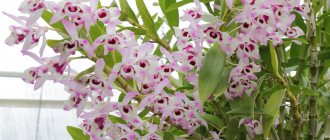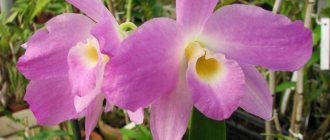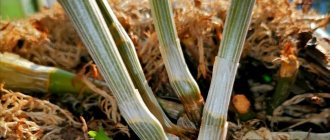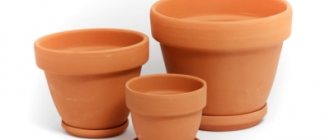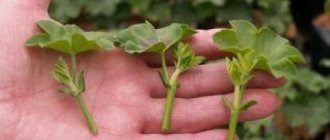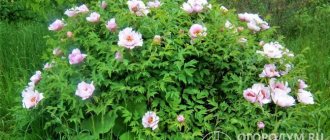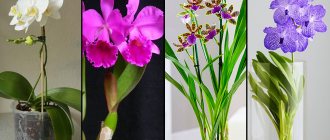Plants » Flowers
0
1644
Article rating
Kira Stoletova
Such a charming plant as dendrobium nobile cannot help but captivate with its decorativeness and grace. Therefore, this exotic flower is a favorite of many gardeners. Today we will tell you how to propagate and replant dendrobium nobile at home, and what kind of care this flower requires.
Description of the Dendrobium Nobile plant and its care
Detailed description and photo
Dendrobium nobile (Dendrobium nobile) or Dendrobium noble is a natural species of the genus Dendrobium from the Orchidaceae family.
From the history
Habitat: high mountain forests of Southeast and South Asia. The first Dendrobium was described by the Swedish botanist Olaf Schwartz. And in 1836, Europe learned about a new species that was found in India. For its pleasant aroma and spectacular flowering, it was given the specific epithet “nobile” - from the Latin noble .
Currently, the natural species is on the list of protected plants (Appendix II of the CITES Convention). For 120 years, many hybrids have been created on its basis, which are grown as a potted crop. Therefore, in the pedigrees of all store-bought Nobile orchids there is only a minimal percentage of the natural species. And the higher it is, the more expensive the plant.
What does Dendrobium nobile look like?
Nobile has the appearance of a tall bush with one or several stems . In the wild, the height reaches a meter, and at home it is about 60 cm.
The stem is elongated pseudobulbs that are divided into segments. Erect, fleshy, glossy, deviating downward over time. At the attachment points of the leaves there are buds that develop into peduncles or sprouts (babies). Every 2-4 years the stems lose leaves, turn yellow and die.
Flowers of different hybrids can be collected in inflorescences of up to 4 pieces each . Flower diameter is from 5 to 10 cm. Petals have a waxy texture. Most often two-colored: white at the base and with lilac, violet, red or orange ends. There are also plain ones: white, pale pink, yellow. The lip is ovoid, with a round purple or yellow spot.
The leaves are linear-lanceolate, light green, located along the length of the stem.
How is it different from other orchids?
Dendrobium nobile forms flower stalks not only at the top of the pseudobulb, but along its entire length.
The number of flowers reaches 70 pieces. Cut flowers remain fresh for about 10 days.
D. noble Irene Smile
Height from 30 to 45 cm. Stems are presented in the form of thick tree-like pseudobulbs. The buds are scattered along the entire length of the trunk, 2-5 cm from each other.
The flowers are delicate, white-lilac with a yellow center and a pleasant aroma. Diameter from 5.5 to 6.5 cm. Blooms once every 6 months. The duration of budding is 4 weeks.
Varieties
The most famous line of hybrids based on Nobile is named after the Japanese breeder - Yamamoto hybrids.
Let's look at the most popular Greeks.
Yellow Song (D. nobile Yelow Song Canary)
The height of the bush is 40 cm, the flowers are single-colored, bright yellow, 6 cm in diameter. The lip is rounded, funnel-shaped, with wavy edges and an orange spot. The aroma is fruity and floral .
Fancy Angel (D. nobile Fancy Angel Lycee)
With a delicate lemon aroma. The stems are 30 cm high. The flowers are velvety, about 6 cm in size. The color of the petals is white and lilac. The lip is white, with a lilac edging and a yellow spot in the center.
Spring Dream (D. nobile Spring Dream Apollon)
Plant height 45 cm. The flowers are white, diameter 5-6 cm, with a large yellow spot on the lip. Petals with wavy edges. The aroma is fresh, fruity and herbaceous .
D. nobile Comet King Akatsuki
An epiphytic plant with dark green lanceolate leaves 30-40 cm high. The bush contains 3-4 bulbs covered with flowers.
The buds are not large, the maximum diameter is 4 cm. The petals are a delicate lilac shade with a purple-yellow center and a white edge.
Dendrobium Nobile Akatsuki flowers have a light floral aroma, more intense in the daytime and barely noticeable in the evening.
Landing
The roots of this orchid do not participate in photosynthesis, but they need good aeration.
Pot - with a drainage hole at the bottom and aeration walls around the circumference (plastic, ceramics, clay). If a flowerpot, then 1 cm wider than the diameter of the pot.
The soil is a mixture of coarse and fine pine bark, sphagnum moss, peat and coal. A ready-made substrate for orchids is suitable.
How to plant correctly:
- A layer of sea stones is placed on the bottom of the pot, and several large pieces of bark are placed on top.
- Install the plant, straighten the roots and add soil 1-2 cm below the edges of the pot.
- The first watering is 3-5 days after planting.
Transfer rules
The dendrobium nobile orchid does not tolerate the transplantation procedure well. But once every 3 years the plant becomes cramped in the old container and simply needs to be replanted.
Replanting varieties that flower in autumn is carried out with the beginning of the growth of young shoots. Species that bloom in spring are replanted after they have completely faded.
The plant is transplanted into a container 2-3 cm deeper than the previous one. To do this, you can use a plastic flowerpot or clay pot. Before transplanting, moisten thoroughly.
Place 2-3 pebbles at the bottom of the container, which will ensure the stability of the flowerpot. Then a drainage layer of pieces of foam or expanded clay is laid. A coarse-grained bark of 2 cm is laid on top, and then I replant the dendrobium nobile using the method of transferring an earthen clod. New store-bought substrate is added on top. The nutritional mixture consists of coconut chips, pine bark, charcoal and sphagnum moss.
Home care
Temperature
- In summer +26…28°С.
- In winter +15…18°С.
Lighting
Hybrids with purple and yellow flowers need bright light, while white and pastel ones are less light-loving. The appropriate mode is determined experimentally:
- new pseudobulbs have become shorter - too much light;
- if longer and thinner - lack of light.
Watering
Water with filtered water after the substrate has completely dried.:
- in the spring-summer period up to 3 times a week;
- in autumn - once a week;
- in winter - once every 2-3 weeks.
Top dressing
Feed during active development, once every 10 days. Do not fertilize during the dormant period. If the plant develops all year round, fertilizing is applied constantly, after every third watering. Ready-made fertilizer for orchids is suitable, 1/2 of the dosage according to the instructions.
Trimming - only dried flower stalks or pseudobulbs.
Transfer
There are two types:
- planned - every 3-4 years, in a pot 2 cm wider than the previous one;
- emergency - immediately after purchase, if the flower is sick, pests appear or the substrate has deteriorated.
How to stimulate flowering?
From November to February, you need to ensure a period of rest (dry, light, cool, +15°C).
After dormancy, the flower is returned to standard mode . The plant is sprayed with a solution of succinic acid (according to the instructions on the package).
Once a week they take a hot shower (up to +50°C).
During flowering, care is usual. After flowering, do not water for a week .
Post-procedure care
Temperature, lighting and humidity
After transplanting, it is recommended to remove the dendrobium to a room with high humidity or provide it with daily spraying and sufficient light (10-15 hours a day).
But under no circumstances should you install it in direct sunlight. The optimal room temperature should be between 22-25° C.
If the transplant is carried out for the purpose of propagation , then the plant is removed to a shaded place with a temperature of about 20° C.
When and how to water?
The plant is not watered immediately after transplantation . The root system must dry well to avoid rot. Watering begins after 7-10 days, carefully, without getting on the leaves, along the edge of the pot onto the substrate.
When and what to feed?
Additional nutrition is provided only during the period of active growth . And since active growth has not yet begun after transplantation, the orchid does not need feeding.
The only thing recommended to do during this period is spraying the leaves with a glucose solution.
How does it reproduce?
The most popular methods of reproduction are:
Children
These are new shoots with roots on the orchid stem.
- They are separated with a knife in the phase of 3-4 leaves and roots more than 3 cm long.
- Plant in a pot with substrate and care for it like an adult plant.
Cuttings
- An old stem without leaves is cut off at the base and divided into parts so that each has 2-3 dormant buds.
- The sections are treated with cinnamon powder.
- The cuttings are placed in a container with a layer of damp sphagnum moss and covered with film.
- The greenhouse is ventilated daily and the moss is periodically moistened.
- In 3 weeks the babies will appear. They are transplanted into pots when the roots grow to 5 cm.
Dividing the bush
- During transplantation, adult, multi-stemmed bushes are divided into parts. A delenka is 1-2 stems with roots.
- It is dried at room temperature for a day and planted in a separate pot.
- The cut areas are treated with crushed coal.
How to replant a bamboo plant with cuttings?
Cuttings can be obtained from old pseudobulbs. This procedure is carried out after the dendrobium has flowered. This method demonstrates good performance. Cuttings are a lengthy process and will take several weeks to produce new plants.
Preparing the cuttings
The cutting is prepared as follows:
- after the plant blooms, take the old bulb;
- make sure that the bulb has buds that did not produce flowers;
- cut into several parts;
- put them in a greenhouse (plastic container with damp moss);
- install the greenhouse in a warm, bright place;
- ventilate daily;
- wait for the babies to emerge.
How to root?
It is believed that children from cuttings are more capricious than those obtained from pseudobulbs. After 3-6 months, when the children appear on the old bulb, it is necessary to wait for the formation of an independent root system. The principle is the same as when growing babies in the axils of an orchid. A small but strong root system is needed!
After this, the young shoots can be separated and planted. Planting of offspring grown in this way is done in the same way as those obtained from the mother plant.
Diseases and pests
- Root rot - roots darken and soften, mold on the substrate, leaves wither. The plant is transplanted into a new pot with a clean substrate, the affected areas are cut off. The preparations “Previkur” or “Bayleton” are added to the irrigation water for a course of 2-3 months.
- Spotting - black, dry spots with yellow edges on the leaves. The affected areas are cut off. The orchid is transplanted and treated with a 1% solution of the preparations “Hom” or “Skor”.
- Thrips are small insects on the undersides of leaves. White marks and yellow spots are visible. Treatment with Mospilan, 3 times every 10 days, will help.
- Spider mites - cobwebs and black spots on leaves. Treat with Fitoverm 2 times with an interval of 12 days.
- Scale - brown tubercles and red-yellow spots on the leaves. A hot shower and 4 treatments with Metaphos every week will help.
Apollo Orchid white
One of the most common decorative types of indoor orchids, the average flowering time is 12 weeks. The fleshy stems are covered with thin skin.
Nobile Apollo is considered an unpretentious plant, but does not tolerate drafts. Transplantation is carried out in the spring, only if necessary, if:
- the root system does not fit in the pot;
- the substrate is damaged.
Sometimes you can find the Nobile Apollo in blue. Don't be alarmed, this is an artificially colored flower. The bright blue pigment is introduced into the plant by injection. But the coloring effect does not last long: the next flowering of Apollo will be ordinary white. Read about blue orchids here.
Read about all the varieties of dendrobuim orchids in this article.
Prevention of various problems
- Shower or spray - only in the morning. Otherwise, the water will not have time to evaporate from the axils of the leaves and rotting will begin. After spraying in bright, midday sun, the leaves will get burned.
- Hard water causes the substrate to quickly become salty, a white coating appears, and the plant does not absorb nutrients well. It is better to use settled water, which will be softened with 2-3 drops of lemon juice.
- Fungal diseases develop from excess moisture and frequent winter watering. For prevention, coal chips are added to the substrate.
- A pinch of cinnamon on the surface of the substrate will protect against the appearance of insects and the development of fungal diseases.
Dendrobium nobile easily reproduces and readily blooms up to 3 times a year. This is the most light-loving orchid. And thanks to the pseudobulbs, which accumulate moisture and nutrients, the plant is unpretentious and easy to care for.
What does the Dendrobium Nobile orchid look like?
The Dendrobium Nobile orchid, also known to gardeners as the “noble” orchid, belongs to one of the many genera that make up the Orchidaceae family. The first scientifically described specimens were discovered in India. In general, the homeland of most plant species is Southeast Asia (Thailand, Cambodia, Vietnam). In nature, the plant lives in tropical forests, is an epiphyte or lithophyte, that is, it settles on tree trunks or rocks, clinging with its roots to the smallest cracks in the bark and stones. The orchid is not a parasite; it needs the “owner” only as a support. The plant is quite hardy and can survive without water for about a month.
In nature, the dendrobium Nobile orchid most often lives in trees.
The peduncles of the dendrobium Nobile orchid are straight and branched. Sometimes they even bend under the weight of numerous buds. The petals are most often colored snow-white, pale lemon, golden-orange, lilac, violet. The diameter of the flower varies from 4 cm to 8–10 cm. It has a very subtle pleasant aroma.
Most often, the petals of the dendrobium Nobile orchid combine several shades, creating a unique play of colors
The plant has successfully adapted to the conditions of modern apartments. The orchid is deservedly considered to be quite capricious, so it is better for the gardener to first practice on less demanding representatives of the family. Suitable for beginner orchids are phalaenopsis and cattleya.
- advantages: blooms often and abundantly, easily propagated;
- disadvantages: does not like dry air, the smell of dendrobium causes allergies in some people.
Dendrobium Nobile belongs to the so-called sympodial orchids - its growth point is at the top of the shoot
Many breeding hybrids have been created based on the dendrobium Nobile orchid. Most of them come from Japan (the so-called Yamamoto group) or from the Netherlands. They differ from “natural” orchids in having larger flowers.
Photo gallery: achievements of breeders
Dendrobium Nobile Anna Green has a crimson-purple lip that stands out effectively against the background of bright lime-colored petals. Petals of dendrobium Nobile Black Beauty have a rich purple tone, sometimes with a chocolate tint, but from a distance they seem almost black. Dendrobium Nobile Jade Green is one of the most popular breeding hybrids Orchid dendrobium NobileLemon Green has a rich, pleasant aroma. Dendrobium Nobile Snow White has a very pure snow-white shade of petals and lips. Blooming dendrobium Nobile Firebird is a real golden-orange “waterfall”
Personal experience
I bought my first Dendrobium Nobile in December 2012. There was very little information, since most articles described the care and maintenance of phalaenopsis.
The main information was that Dendrobium Nobile is a difficult orchid to care for, that it should dry out between waterings, stop watering after the “stop leaf” appears and do not water it until flowering, and keep it in a cool place during the dormant period.
Nobile placed her Dendrobium in the southwest window. I watered by soaking, and determined the next watering by the pseudobulbs: if they shriveled, it was time to water. After the “stop leaf” appeared on the pseudobulb, watering was stopped until flowering.
The first home flowering was only three to four years after purchase. The reason was that there was only one pseudobulb when purchased. Dendrobium Nobile needed to grow green mass.
Important! When purchasing dendrobium, pay attention to the number of pseudobulbs, there should be at least three. If less, the plant is considered weak and may not survive.
In 2022, I decided to change my care: I didn’t dry it out during the growth period, but in the summer I took it out to the summer veranda and fed it. The pseudobulb has grown twice as much as last year.
New growth appeared in August. In past years, there was only one increase per year. Let's see how it blooms.
Watering
You cannot water the plant right away . It is necessary that the cut roots dry well. If before planting in the ground the roots of the plant were dried in the open air for up to 2 hours, then watering should be done no earlier than 2-3 days after transplantation.
In case of extreme heat, the orchid should be watered within 24 hours. If the roots were air-dried for 8-10 hours, then the transplanted flower should be watered immediately after being placed in the substrate. This will allow the roots to take root faster.

